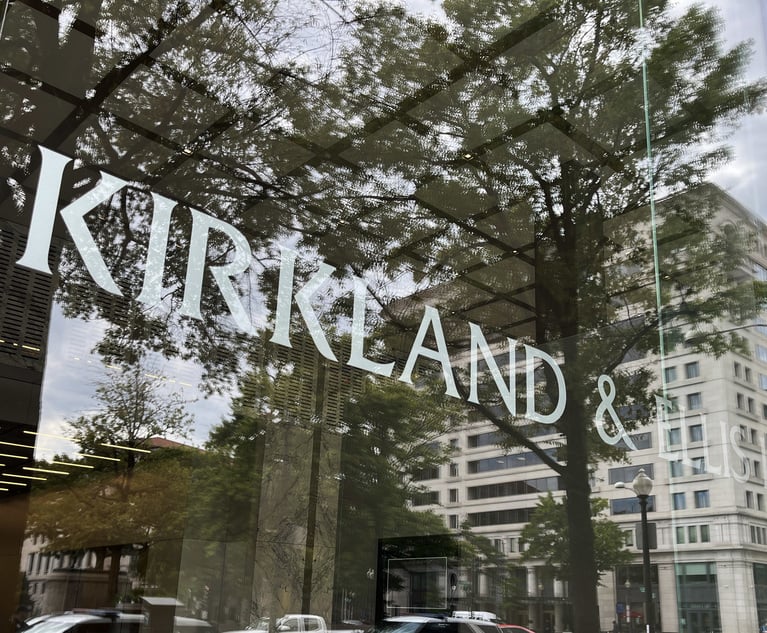Are Legal Departments Really Better Than Firms at Diversity?
Legal departments are generally more inclusive than big law firms, but diversity advocates said there's still work to be done, especially at the general counsel level.
March 10, 2019 at 03:02 PM
8 minute read
The original version of this story was published on Corporate Counsel
 Photo: Shutterstock.com
Photo: Shutterstock.com
General counsel have trained their sights on law firms when it comes to diversity, demanding to see improvement in the number of minorities among those being elevated to partner or those working on their matters. At the same time, legal departments have their own struggles with diversity, particularly when it comes to the top spot.
Lawyers told The American Lawyer affiliate Corporate Counsel that in-house teams tend to be more diverse than big law firms overall, but that edge wanes when it comes to general counsel roles. In 2018, fewer than 20 percent of Fortune 500 general counsel were people of color and around one-third were women.
Sources attributed the lack of diversity at the GC level to unconscious bias in work assignments, fewer mentorship opportunities and a leadership recruitment process that draws from big law firms, where the majority of partners are white and male.
“How are [companies] having diverse teams if the law firms, the very places you go to, are not diverse? You're demanding diversity. That forces the law firms to say, we should think about ways to get diverse people,” said Jean Lee, the president and CEO of the Minority Corporate Counsel Association. “Who is doing that for corporations? Because they're the client. The C-suite and the board are starting to diversify because the shareholders, consumers, public opinion is forcing them to.”
Jennifer Salinas, the president of the Hispanic National Bar Association, said some companies are starting to address the legal pipeline, which she said is necessary for growing diverse representation at the GC level.
The pipeline in-house often, though not always, looks like this: law school to firm, firm to legal department. If that pipeline gets stuck at law school or firms, in-house hiring and promotion could be impacted, lawyers said.
Makalika Naholowaa, a former National Native American Bar Association board member and executive officer and in-house counsel at Microsoft, noted many law schools admit fewer than one Native American student a year. Until that changes, she said it's difficult to increase Native American representation at later pipeline points.
“Everybody all along the pipeline needs to be mindful and inclusive of Native Americans in their efforts,” Naholowaa said. “But I also think if you don't see a real, intentional, significant change among law school admission groups, you aren't going to see measurable change anywhere else.”
Big law's inclusion problem comes in-house
In-house counsel can push schools to accept more diverse students by creating a demand at law firms, Naholowaa said. At the moment, many big law firms are still disproportionately white and male, though companies have started diversity incentives or requirements for outside counsel.
The Minority Corporate Counsel Association's 2018 Law Firm Diversity Survey found around 17 percent of lawyers at responding U.S. firms were racial or ethnic minorities. Only 9 percent of firm partners were people of color.
Diversity has increased for firm's incoming classes, but retention issues remain. Last year, more than 20 percent of departing firm lawyers were people of color; that number rose to 28 percent for associate departures. Robert White, the executive director of the California Minority Counsel Program, said his group surveyed black associates about their future career plans and found many planned to leave their current firm for a company legal department.
“A decent percentage felt they had a chance to advance and make partner at their firms. However, a really large percentage felt it was unlikely they would be at that firm in three years,” White said. “Another question asked: if you leave your law firm, where are you most likely to go? And the clear majority of interest was moving to an in-house position.”
Escaping the lack of upward mobility for women and people of color at firms by moving in-house may be a catch-22, some lawyers warned.
Many companies seek a general counsel with experience as a partner or senior associate, Salinas said, and moving in-house before landing a partner or senior associate role could stagnate opportunities for growth within a legal department.
“While it's good that in-house legal departments are more diverse, perhaps we should be encouraging diverse attorneys to get that experience and senior leadership skills before they go in-house,” Salinas said. “Or be very intentional when you are in-house that you need those skill sets.”
A 'very limited pipeline' brings recruitment issues
Some companies have taken the early career pipeline challenges into their own hands. But Laurie Robinson-Haden, the founder and CEO of Corporate Counsel Women of Color, notes it's also crucial for legal departments to develop and grow the talent already available.
Susanna McDonald, the vice president and chief legal officer of the Association of Corporate Counsel, said that may not happen if GCs search the same white, male-dominated markets for new hires. She suggested companies expand beyond that “very limited pipeline” of big law firms to include affinity bar associations and smaller, more diverse firms.
While GCs at 170 companies signed a letter pushing for diversity at firms in January, Salinas said many are still not tapping into affinity group networks for their own legal department hiring.
“You put this call to action out there, but what are people doing with that? How are people going to heed that request? What are you doing internally to make sure your own talent pool is also diverse?” Salinas said.
White said many companies are more up-front about “what they're doing to drive diversity at their law firms than they are about what's happening internally.” Lee noted many legal departments are reluctant to share their diversity stats, which makes it harder to track hiring trends in-house.
A lack of structured, inclusive mobility programs in-house
Once attorneys of color land an in-house role, barriers can still remain.
A survey from Corporate Counsel Women of Color found many women of color felt excluded from challenging work that offered opportunities for growth and promotion, mentorship opportunities and leadership succession plans at work. Robinson-Haden said companies can be more intentional about developing talented in-house counsel of color.
Linda Lu, co-chairwoman of the National Asian Pacific American Bar Association's In-House Counsel Network, said she's seen companies successfully provide growth opportunities for diverse lawyers by implementing formal programs and metrics.
In both legal departments, and even more so firms, landing quality, rewarding assignments and mentorships can depend on lawyers' relationships with legal department leaders. Biases can play into which lawyers get those opportunities under a subjective assignment or mentorship model.
“The way that companies can combat that issue is, you have to be very deliberate in having formalized programs to identify high talent and get them the exposure and visibility,” Lu said.
Sending a message from the organization's top and focusing on a companywide culture of diversity and inclusion can keep efforts sustainable.
Lee noted this means giving employees credit for diversity and inclusion work, which many companies currently don't do. Robinson-Haden said companies with a strong culture of diversity and inclusion, and those who value diversity initiative efforts as real work, will have growth that withstands leadership changes because programs aren't only getting buy in from a few people.
Informing employees of diversity's business incentives—wider market perspectives, more backgrounds contributing ideas—can also help get wider buy in for inclusion exercises and policies. Naholowaa said she's seen affinity organizations showcase their racial or ethnic group's contribution to the company, as employees and customers.
It's helpful to include everyone at the company in diversity conversations, Naholowaa said, teaching the principles of inclusion generally rather than narrowing in on certain identities, such as gender or ethnicity.
“You're not going to be culturally competent in all the ways people are different. That's a losing battle. … What you can do is focus on how do we just operate in an inclusive way?” Naholowaa said. “What that ends up looking like is listening to people, asking questions. Don't make assumptions. Ask yourself, am I being fair? If you can apply those frameworks to teach people how to be inclusive in general, it will do a whole lot.”
Read More:
Harassment From Clients Can Stunt Women's Careers, but Few Firms Are Trying to Stop It
170 GCs Pen Open Letter to Law Firms: Improve on Diversity or Lose Our Business
A Black Partner Responds to GCs on Law Firm Diversity
Women GCs Face Sexism, Stereotypes From Firm Lawyers—And It Impacts Who They Hire
This content has been archived. It is available through our partners, LexisNexis® and Bloomberg Law.
To view this content, please continue to their sites.
Not a Lexis Subscriber?
Subscribe Now
Not a Bloomberg Law Subscriber?
Subscribe Now
NOT FOR REPRINT
© 2025 ALM Global, LLC, All Rights Reserved. Request academic re-use from www.copyright.com. All other uses, submit a request to [email protected]. For more information visit Asset & Logo Licensing.
You Might Like
View All
Kirkland Is Entering a New Market. Will Its Rates Get a Warm Welcome?
5 minute read

Why Associates in This Growing Legal Market Are Leaving Their Firms

Trending Stories
- 1‘Catholic Charities v. Wisconsin Labor and Industry Review Commission’: Another Consequence of 'Hobby Lobby'?
- 2With DEI Rollbacks, Employment Lawyers See Potential For Targeting Corporate Commitment to Equality
- 3In-House Legal Network The L Suite Acquires Legal E-Learning Platform Luminate+
- 4In Police Shooting Case, Kavanaugh Bleeds Blue and Jackson ‘Very Very Confused’
- 5Trump RTO Mandates Won’t Disrupt Big Law Policies—But Client Expectations Might
Who Got The Work
J. Brugh Lower of Gibbons has entered an appearance for industrial equipment supplier Devco Corporation in a pending trademark infringement lawsuit. The suit, accusing the defendant of selling knock-off Graco products, was filed Dec. 18 in New Jersey District Court by Rivkin Radler on behalf of Graco Inc. and Graco Minnesota. The case, assigned to U.S. District Judge Zahid N. Quraishi, is 3:24-cv-11294, Graco Inc. et al v. Devco Corporation.
Who Got The Work
Rebecca Maller-Stein and Kent A. Yalowitz of Arnold & Porter Kaye Scholer have entered their appearances for Hanaco Venture Capital and its executives, Lior Prosor and David Frankel, in a pending securities lawsuit. The action, filed on Dec. 24 in New York Southern District Court by Zell, Aron & Co. on behalf of Goldeneye Advisors, accuses the defendants of negligently and fraudulently managing the plaintiff's $1 million investment. The case, assigned to U.S. District Judge Vernon S. Broderick, is 1:24-cv-09918, Goldeneye Advisors, LLC v. Hanaco Venture Capital, Ltd. et al.
Who Got The Work
Attorneys from A&O Shearman has stepped in as defense counsel for Toronto-Dominion Bank and other defendants in a pending securities class action. The suit, filed Dec. 11 in New York Southern District Court by Bleichmar Fonti & Auld, accuses the defendants of concealing the bank's 'pervasive' deficiencies in regards to its compliance with the Bank Secrecy Act and the quality of its anti-money laundering controls. The case, assigned to U.S. District Judge Arun Subramanian, is 1:24-cv-09445, Gonzalez v. The Toronto-Dominion Bank et al.
Who Got The Work
Crown Castle International, a Pennsylvania company providing shared communications infrastructure, has turned to Luke D. Wolf of Gordon Rees Scully Mansukhani to fend off a pending breach-of-contract lawsuit. The court action, filed Nov. 25 in Michigan Eastern District Court by Hooper Hathaway PC on behalf of The Town Residences LLC, accuses Crown Castle of failing to transfer approximately $30,000 in utility payments from T-Mobile in breach of a roof-top lease and assignment agreement. The case, assigned to U.S. District Judge Susan K. Declercq, is 2:24-cv-13131, The Town Residences LLC v. T-Mobile US, Inc. et al.
Who Got The Work
Wilfred P. Coronato and Daniel M. Schwartz of McCarter & English have stepped in as defense counsel to Electrolux Home Products Inc. in a pending product liability lawsuit. The court action, filed Nov. 26 in New York Eastern District Court by Poulos Lopiccolo PC and Nagel Rice LLP on behalf of David Stern, alleges that the defendant's refrigerators’ drawers and shelving repeatedly break and fall apart within months after purchase. The case, assigned to U.S. District Judge Joan M. Azrack, is 2:24-cv-08204, Stern v. Electrolux Home Products, Inc.
Featured Firms
Law Offices of Gary Martin Hays & Associates, P.C.
(470) 294-1674
Law Offices of Mark E. Salomone
(857) 444-6468
Smith & Hassler
(713) 739-1250










